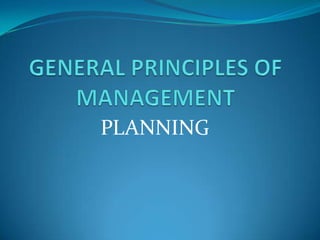
Gpm iii - planning
- 1. PLANNING
- 2. DEFINITION (1) SELECTING MISSIONS AND OBJECTIVES AS WELL AS THE ACTIONS TO ACHIEVE THEM, WHICH REQUIRES DECISION MAKING, THAT IS CHOOSING A COURSE OF ACTION AMONGST ALL ALTERNATIVES
- 3. DEFINITION (2) DECIDING IN ADVANCE ABOUT THE OBJECTIVES TO BE PURSUED BY THE ENTERPRISE; THE SELECTION OF BEST ALTERNATIVE COURSES OF ACTION TO REACH THOSE OBJECTIVES AND A SPECIFICATION OF ACTIVITIES – TECHNICAL, FINANCIAL, PERSONNEL ETC. REQUIRED FOR THE IMPLEMENTATION OF PRE- SELECTED COURSES OF ACTION
- 4. “Planning is an intellectually demanding process; it requires the conscious determination of courses of action and the basing of decisions on purpose, knowledge, and considered estimates.” - Koontz and O’Donnell
- 5. “Planning is the continuous process of making present entrepreneurial (risk taking) decisions systematically and with best possible knowledge of their futurity, organising systematically the efforts needed to carry out these decisions and measuring the results of these decisions against the expectations through organised, systematic feed-back” - Peter F. Drucker
- 6. NATURE OF PLANNING Planning is goal-oriented Planning has a reference to future Primary function of management Planning involves choice It is an intellectual exercise Planning is all-pervasive
- 7. NATURE OF PLANNING Planning is both – long range and short range Planning is continuous Planning is actionable Planning is flexible It is an integrated system Planning is efficient
- 8. IMPORTANCE OF PLANNING Effective performance – understand - mission & objectives and the methods of attaining Group effort – effective – know what they are to accomplish Basic management function (read slide 1) – planning requires decision making – provides a rational approach Strongly implies managerial innovation Bridges the gap between where we are to where we want to go Plans furnish the standards of control
- 9. Close relationship of Planning and Controlling NEW PLANS IMPLEMENTATION NO PLANNING CONTROLLING OF PLANS UNDESIRA : COMPARING BLE PLANS WITH DEVIATION S FROM RESULTS PLANS UNDESIRABLE DEVIATION CORRECTIVE ACTION
- 10. TYPES OF PLANS MISSION OR PURPOSE OBJECTIVES OR GOALS STRATEGIES POLICIES PROCEDURE RULES PROGRAMS BUDGETS
- 11. TYPES OF PLANS MISSION OR PURPOSE: The basic purpose of function or tasks of an enterprise or agency or any part of it OBJECTIVES OR GOALS: The ends toward which activity is aimed STRATEGIES: The determination of basic long term objectives of an enterprise and the adoption of courses of action and allocation of resources necessary to achieve these goals
- 12. TYPES OF PLANS POLICIES: General statements or understandings that guide or channelize thinking in decision making PROCEDURES: Plans that establish a required method of handling future activities RULES: Spell out specific required actions or non actions, allowing no discretion
- 13. TYPES OF PLANS PROGRAMS: A complex of goals, policies, procedures, rules, task, assignments, steps, to be taken, resources to be employed, and other elements necessary to carry out a given course of action BUDGETS: A statement of expected results expressed in numerical terms.
- 14. STEPS IN PLANNING Being aware of opportunities Setting objectives or goals Considering planning premises Identifying alternatives Comparing alternatives in light of goals sought Choosing an alternative Formulating supporting plans Quantifying plans by making budgets
- 15. Be aware of opportunities In light of: The Market Competition What customers want Our weaknesses
- 16. Setting objectives or goals Where we want to be and what we want to accomplish and when
- 17. Considering planning premises In what environment – internal or external – will our plans operate
- 18. Identifying alternatives What are the most promising alternatives in accomplishing our objectives?
- 19. Comparing alternatives in light of goals sought Which alternative will give us the best chance of meeting our goals at the lowest cost and highest profit?
- 20. Choosing an alternative Selecting the course of action we will pursue
- 21. Formulating supporting plans Such as plans to: buy equipment Buy materials hire and train workers develop a new product
- 22. Quantifying plans by making budgets Develop such budgets as: Volume and price of sales Operating expenses necessary for plans Expenditures for capital equipment
- 23. PROCESS OF PLAN DEVELOPMENT BUILDING DEVELOPMENT OF PLANS SECONDARY PREMISING FOUNDATION FORECASTING PRIMARY FOUNDATION
- 24. CONCEPT OF PLANNING PREMISES Key step in planning It refers to anticipated environment in which plans are expected to operate. It includes assumption or forecasts of the future and known conditions that will affect the operation of plans
- 25. CLASSIFICATION OF PLANNING PREMISES INTERNAL AND EXTERNAL PREMISES CONTROLLABLE AND UNCONTROLLABLE PREMISES QUANTITATIVE AND QUALITATIVE PREMISES
- 26. INTERNAL PREMISES They are relevant internal conditions of the enterprise on which plans will be based. Examples: Management strategies, policies and programmes Organisational structural flexibilities Manpower potential Availability of finances Approved sales forecast etc
- 27. EXTERNAL PREMISES Relevant external conditions on which plans will be based Example: Political conditions Social conditions Economic conditions Technological conditions Factors market conditions
- 28. CONTROLLABLE PREMISES Examples: Advertising programmes and policies Expansion programmes Policy of centralisation/decentralisation
- 29. UNCONTROLLABLE PREMISES Examples: Population growth Price trends Political environment Technological environment
- 30. SEMI-CONTROLLABLE PREMISES Examples: Labour turnover Labour efficiency Pricing policy
- 31. QUANTITATIVE PREMISES Expressed numerically; premises are tangible Examples: Finance availability Sales forecasts Population trends Price trends Plant capacity utilisation
- 32. QUALITATIVE PREMISES Cannot be expressed; intangible Examples: Human relations in the enterprise Morale of employees Prestige or reputation of the enterprise Political stability
- 33. ADVANTAGES OF PLANNING 1. Helps in achieving objectives 2. Better utilisation of resources 3. Economy in operation 4. Reduces uncertainty and risk 5. Improves competitive strength 6. Effective control 7. Coordination 8. Encourages motivation 9. Guides in decision making 10. Provides decentralization 11. Improves efficiency 12. Anticipation of crisis
- 34. LIMITATIONS OF PLANNING 1. Lack of accurate information 2. Time and cost 3. Inflexibility 4. Delay during emergency period 5. False sense of security
